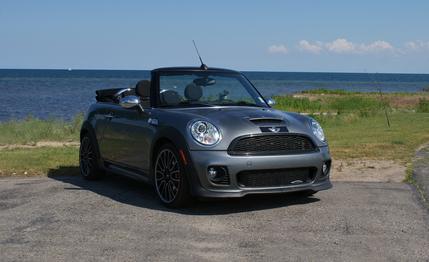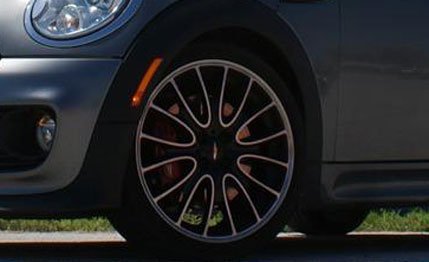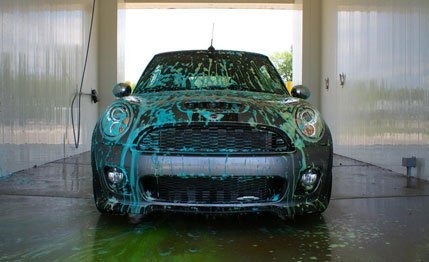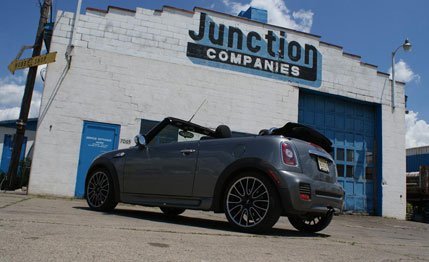
 Long-Term Road Test Wrap-Up
Long-Term Road Test Wrap-Up
Date: December 2010
Months in Fleet: 14 months
Current Mileage: 40,000 miles
Average Fuel Economy: 28 mpg
Range: 363 miles
Service: $262
Normal Wear: $3925
Repair: $469


In the summer of 2009, we set out to determine the 40,000-mile hardiness of the Mini John Cooper Works convertible, a tiny car that has the features—and price—of larger and more established near-luxury competitors. We discovered early what we loved about our Mini: its accessory-fueled good looks; its barking, popping exhaust note; and its rewarding and willing handling on smooth roads.
It also didn’t take long to determine what we hated most. The ride quality on Michigan’s terrible streets was about as punishing as any we’d experienced from a factory vehicle, garnering complaints in nearly every logbook comment—a rare case of total unanimity among the C/D editorial staff. If you think we’re whiners, objective evidence of the jackhammering exists in the routine skipping of CDs and radar detectors that literally fell from the windshield. We initially thought our handsome but oversized 18-inch wheels and the short-sidewall tires might be to blame, but the situation didn’t improve much with the stock 17-inch wheels and softer-compound winter tires. Ultimately, we pinned the poor ride on the car’s short wheelbase and overly harsh Works suspension tuning.
Ergonomics as Ridiculous as the Price


Other issues would be less egregious if our car were less expensive, but as we’ve previously noted, our test vehicle was quite possibly the priciest Mini ever built, running $46,244. To the base price of $34,950, we added $3600 in factory options and another $7500 (!) in dealer accessories. (A full equipment rundown can be found in our long-term introduction to the car. Given that Minis are highly accessorized and customized, we thought we’d be thorough in evaluating the available add-ons. Perhaps we were a bit too thorough?)


The result was one sweet-looking little machine, but one that still lacked the reasonable level of comfort and convenience we’d expect from something costing so much. For example, our Mini baffled with unintuitive controls and ergonomics. Tuning the radio was an inscrutable task, the volume knob was positioned inconveniently, and the tachometer was mostly blocked by the steering wheel. Further, the radio display disappeared when you were wearing polarized sunglasses, and the rear window turned opaque from road grime minutes after a carwash. Finally, the stereo’s sound quality was so bad we’d have been disappointed if it were found in a car one-quarter of the cost. An upgrade audio system is available (we restrained ourselves in the name of cost control—har-har), but one would assume the base setup in a $35,000 car would be tolerable.
Given the wide range of accessories fitted to our car, the various levels of satisfaction with the gear were to be expected. The 18-inch wheels won praise for their design, even if they worsened the ride and weren’t very durable (more on that in a bit). The body kit was aggressive enough that even straight guys felt comfortable driving a Mini convertible, and the twin black stripes smeared down the hood and tailgate added to the car’s racy aesthetics. The Alcantara steering wheel’s bespoke look, resistance to frigid temperatures, and supreme comfort and grippiness made it the undisputed favorite extra. We weren’t as happy with the other gewgaws. The steering-column-mounted shift lights are poorly executed, but at least they were occasionally useful, which we couldn’t say about the lateral-g meter. It was hard to look at while cornering, and it lacked the ability to record data. We used the Sirius satellite radio and complicated iPod interface, but the sound quality from these sources was still terrible.
Shaking and Rattling to Make Bill Haley Proud
Our Mini didn’t age well, a fact reflected in the logbook comments and attributable to abuse from our pockmarked roads. At 3000 miles, we noted that it was “starting to feel loose already.” At 7500, the top was “constantly squeaking and rattling.” At 8500, the car had “more rattles than an 11-year-old Cavalier.” At 14,000, one staffer wrote that he felt “like the car were going to implode.” At 15,000, the doors were sagging badly enough that the handles required “roughly double the already-high effort to open.” A dealer visit didn’t solve the problem, and the sagging got worse throughout the test. At 36,500, the power windows wouldn’t operate in unison.


Maintenance costs once we hit 40,000 miles were as high as you’d expect, given the machine’s cost of entry. The Mini’s best feature was its powerful turbo four, but its 208 hp burned through four tires, which cost $1115 to replace. We also replaced the clutch, which cost a heart-stopping $2810; blame our overindulgence in the throttle and the pedal’s vague takeup, which was difficult to get used to even for drivers with thousands of miles behind the wheel. (To make matters worse, the clutch pedal developed a hitch in the middle of its travel near the end of the Mini’s stay.) At 23,500 miles, one of the gorgeous 18-inch wheels was irreparably chunked by a dirt-road pothole; the low-profile, run-flat tires that felt like concrete might actually have been made of concrete, as the rubber itself emerged unscathed. A replacement wheel was $434, which seems semireasonable for an 18-inch rim as pretty as this one. The 36,000-mile service, which would have been covered under the 36,000-mile maintenance warranty if performed on schedule, cost us $262 because we were late by a couple thousand miles.
Even So, We Did Have Fun
Despite the costs and hassles, our Mini never failed to garner smiles and compliments. With the top down and the exhaust ripping, we could forget about the little annoyances, if not the larger ones. If we had half a collective brain, we’d move from Michigan to someplace warmer with smoother tarmac, but we don’t, so our chances to relish this Mini in its ideal habitat were limited. Performance-wise, the Mini was fairly quick, although it lost a 10th in the 0-to-60-mph sprint over the course of our test, turning in a 6.4-second time with 40K on the clock. The car did, however, pick up 0.2 second when running all the way to 100 mph. Braking from 70 mph improved by nine feet, and it clung to the skidpad a little more tenaciously at the end of its stay, to the tune of 0.92 g. The Mini averaged 28 mpg over 40,000 miles, which is pretty good, considering how much time the throttle spent pinned to the floor.


Ultimately, it wasn’t this Mini’s size, its limited cargo capacity, or even the ergonomics that turned us off; it was the overall lack of refinement and durability that did it in. A JCW coupe would have had a more rigid body and therefore would have developed fewer rattles, had more precise handling, and offered a better ride. As it sits, the JCW convertible is an expensive novelty—a hot, amazing-sounding novelty that’s a lot of fun on the right day for the right person. We have no doubt that a few dozen folks out there would find this car exactly to their tastes—even at this price—it’s just that none of those people work here.